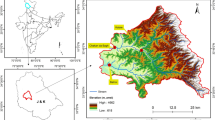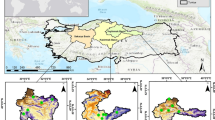Abstract
Estimation of flushing time (T F) in an estuary is important for water quality analysis, and it is one of the major transport time scales used in estuaries to quantify the hydrodynamic processes and for water resources management strategies. Thus, the main objective of the present study was to estimate the T F in the Mandovi estuary (a monsoonal estuary) on the west coast of India. In the study, field observations of salinity (FOS) and a numerical model are used to describe the T F during the south-west monsoon (heavy river discharge), post-monsoon (moderate river discharge) and pre-monsoon (negligible river discharge). T F was calculated for 12 (months) river discharge scenarios (the calculation was done under monthly mean flow conditions). Among the 12 scenarios, four scenarios were within an extremely low flow range: 0.8–2.2 m3s−1; four were in a moderate flow range: 4.3–67 m3s−1; and the remaining four were in a high flow range: 119.0–506.6 m3s−1. The T F calculated from FOS and numerical model showed good matches during the periods of heavy river discharge and moderate river discharge. The results from FOS (numerical model) showed that the T F was 1.12 (1.11) days for a river flow of 506.6 m3s−1 (during the south-west monsoon), and the T F reached 251.28 (592.38) days under extreme low flow of 0.8 m3s−1 (during the pre-monsoon). Regression equations fitted by power and exponential functions were derived from FOS and numerical model simulations to correlate T F with monthly mean river discharges. The power regression equation derived from FOS (numerical model) showed good statistical fit with data (r = −0.997 (−1.0)) for any given river discharge compared to the exponential regression equation (r = −0.81 (−0.80)). Hence, the power regression equation can be used for the rapid evaluation of the impact of drought (during the pre-monsoon) and flood (during the SW monsoon) scenarios in the estuary.






Similar content being viewed by others
References
Alagarsamy R (2006) Distribution and seasonal variation of trace metals in surface sediments of the Mandovi estuary, west coast of India. Estuar Coast Shelf Sci 67:333–339
Alber M, Sheldon JE (1999) Use of a date-specific method to examine variability in the flushing time of Georgia estuaries. Estuar Coast Shelf Sci 49:469–482
Asselin S, Spaulding ML (1993) Flushing times for the Providence River based on tracer experiments. Estuaries 16(4):830–839
Bowden KF (1967) Circulation and diffusion. In: Lauff GH (ed) Estuaries, American Association for Advancement of Science, Publication No. 83, Washington, DC, pp 15–36
Cifuentes LA, Schemel LE, Sharp JH (1990) Qualitative and numerical analyses of the effects of river inflow variations on mixing diagrams in estuaries. Estuar Coast Shelf Sci 30:411–427
Delhez EJM (2006) Transient residence and exposure times. Ocean Sci 2:1–9
Dronkers J, Zimmerman JTF (1982) Some principles of mixing in tidal lagoons. Oceaonologica Acta 4 (suppl) 107–118
Dyer KR (1973) Estuaries: a physical introduction. Wiley, New York
Dyer KR (2000) Estuaries: a physical introduction, 2nd edn. Wiley, New York
Fisher HB, List EJ, Koh RCY, Imberger J, Brooks NH (1979) Mixing in Inland and coastal waters. Academic Press, New York
Gourgue O, Deleersnijder E, White L (2007) Toward a generic method for studying water renewal, with application to the epilimnion of Lake Tanganyika. Estuar Coast Shelf Sci 74:628–640
Huang W (2007) Hydrodynamic modelling of flushing time in a small estuary of North Bay, Florida, USA. Estuar Coast Shelf Sci 74:722–731
Huang W, Spaulding M (2002) Modelling residence time response to freshwater input in Apalachicola Bay, Florida, USA. Hydrol Process 16:2051–3064
Huang W, Chen X, Flannery MS (2011) Critical flow for water management in a shallow tidal river based on estuarine residence time. Water Resour Manage 25:2367–2385
Kessarkar PM, Rao VP, Shynu R, Mehra P, Viegas BE (2010) The nature and distribution of particulate matter in the Mandovi estuary, central west coast of India. Estuaries Coasts 3:30–44
Khodse VB, Bhosle NB, Prabhu Matondkar SG (2010) Distribution of dissolved carbohydrates and uronic acids in a tropical estuary, India. J Earth Syst Sci 119(4):519–530
Knauss JA (1978) Introduction to physical oceanography. Prentice Hall, Englewood Cliff, NJ
Manoj NT (2008) Numerical modelling of tidal circulation and salinity distribution in the Mandovi and Zuari estuaries. Ph.D. Thesis. National Institute of Oceanography, Dona Paula, Goa, India, pp 109. (http://drs.nio.org/drs/handle/2264/3415)
Manoj NT, Unnikrishnan AS (2009) Tidal circulation and salinity distribution in the Mandovi and Zuari estuaries: case study. J Waterway Port Coastal Ocean Eng ASCE 135(6):278–287
Manoj NT, Unnikrishnan AS, Sundar D (2009) Tidal asymmetry in the Mandovi and Zuari estuaries, the west coast of India. J Coastal Res 25(6):1187–1197
Maya MV, Melena AS, Rajesh A, Pratihary AK, Supriya K, Hema N, Naqvi SWA (2011) Variations in some environmental characteristics including C and N stable isotopic composition of suspended organic matter in the Mandovi estuary. Environ Monit Assess 175:501–517
Monsen NE, Cloern JE, Lucas LV, Monismith SG (2002) A comment on the use of flushing time, residence time, and age as transport time scales. Limnol Oceanogr 47(5):1545–1553
Nigam R, Panchang R, Banerjee P (2005) Foraminifera in surface sediments of Mandovi River estuary: indicators for mining pollution and high sea stand in Goa, India. J Coastal Res 21(4):853–859
Officer CB (1976) Physical oceanography of estuaries (and associated coastal waters). Wiley, New York
Olsen SB, Padma TV, Richter BD (2006) Managing freshwater inflows to Estuaries: a methods guide. USAID/Nature Conservancy/Coastal Resources Center, The University of Rhode Island, 44 p
Orfila A, Jordi A, Basterretxea G, Vizoso G, Marbá N, Duarte CM, Werner FE, Tintoré J (2005) Residence time and Posidonia oceanica in Cabrera Island National Park Spain. Cont Shelf Res 25:1339–1352
Pritchard DW (1960) Salt balance and exchange rate for Chincoteague Bay. Chesapeake Sci 1:48–57
Ramanadhan R, Rao PV, Patnaik JK (1973) Break in the Indian summer monsoon. Pure Appl Geophys 104:635–647
Rameshkumar MR, Dessai URP (2004) A new criterion for identifying breaks in monsoon conditions over the Indian subcontinent. Geophys Res Lett 31(18):L18201
Suprit K, Shankar D (2008) Resolving orographic rainfall on the Indian west coast. Int J Climatol 28:643–657
Thomann R, Muller J (1987) Principle of surface water quality modelling and control. Harper & Row Publishers, New York
Unnikrishnan AS, Shetye SR, Gouveia AD (1997) Tidal propagation in Mandovi and Zuari estuarine network, west coast of India: impact of freshwater influx. Estuar Coast Shelf Sci 45:737–744
Vecchi GA, Harrison DE (2002) Monsoon breaks and sub-seasonal sea surface temperature variability in the Bay of Bengal. J Clim 15(12):1485–1493
Vijith V, Sundar D, Shetye SR (2009) Time-dependence of salinity in monsoonal estuaries. Estuar Coast Shelf Sci 85:601–608
Wolanski E (2007) Estuarine echo-hydrology. Elsevier, Amsterdam
Zimmerman JTF (1988) Estuarine residence time. In: Kjerfve B (ed) Hydrodynamics of Estuaries, vol 1. CRC Press, Boca Raton, pp 75–84
Acknowledgments
The author acknowledges the research fellowship from Council of Scientific and Industrial Research (CSIR), Government of India, and financial support from the Department of Science and Technology (DST), Government of India, during this work. The author also thanks Dr. A. S. Unnikrishnan, Mr. D. Sundar and Mr. V. Vijith for their help and valuable suggestions during this work. This is NIO’s contribution number 5203.
Author information
Authors and Affiliations
Corresponding author
Rights and permissions
About this article
Cite this article
Manoj, N.T. Estimation of flushing time in a monsoonal estuary using observational and numerical approaches. Nat Hazards 64, 1323–1339 (2012). https://doi.org/10.1007/s11069-012-0302-6
Received:
Accepted:
Published:
Issue Date:
DOI: https://doi.org/10.1007/s11069-012-0302-6




